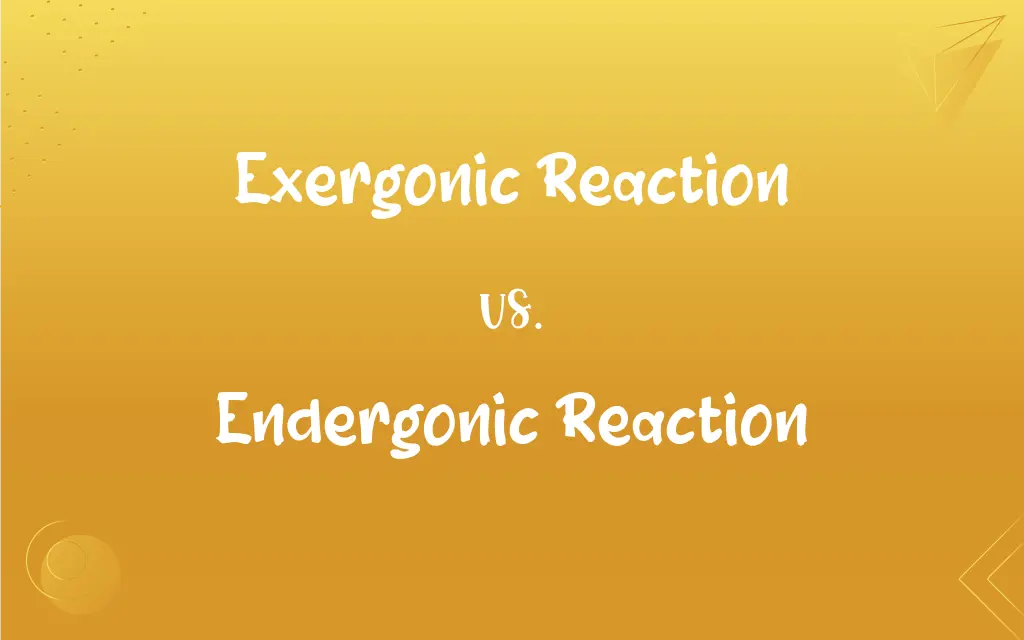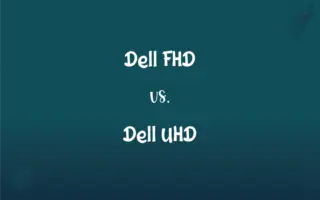Exergonic Reaction vs. Endergonic Reaction: What's the Difference?
Edited by Aimie Carlson || By Janet White || Published on October 12, 2024
Exergonic reactions release energy, typically occurring spontaneously, while endergonic reactions absorb energy and are non-spontaneous.

Key Differences
Exergonic reactions involve the release of energy into the environment, often in the form of heat. Endergonic reactions, in contrast, require an input of energy to proceed.
Exergonic reactions typically occur spontaneously as they lead to an increase in entropy. Endergonic reactions are non-spontaneous and need energy to be driven forward.
In exergonic reactions, Gibbs free energy (ΔG) is negative, indicating a loss of free energy. For endergonic reactions, ΔG is positive, reflecting the absorption of free energy.
Cellular respiration is an example of an exergonic reaction, where glucose is broken down releasing energy. Photosynthesis in plants is an endergonic process, requiring energy from sunlight to synthesize glucose.
In exergonic reactions, ATP (adenosine triphosphate) is often broken down, releasing energy. In endergonic reactions, ATP is typically synthesized or used up to provide the necessary energy.
ADVERTISEMENT
Comparison Chart
Energy Change
Releases energy
Absorbs energy
Spontaneity
Usually spontaneous
Non-spontaneous
Gibbs Free Energy (ΔG)
Negative
Positive
Biological Example
Cellular respiration
Photosynthesis
ATP Role
Often involves ATP breakdown
Involves ATP synthesis or usage
ADVERTISEMENT
Exergonic Reaction and Endergonic Reaction Definitions
Exergonic Reaction
In exergonic reactions, the products have less energy than the reactants.
The reaction of sodium and chlorine to form table salt is exergonic.
Endergonic Reaction
Endergonic reactions are essential in anabolic pathways in living organisms.
The synthesis of ATP from ADP and inorganic phosphate is an endergonic reaction.
Exergonic Reaction
Exergonic reactions often occur spontaneously and are associated with energy release.
Rusting of iron is an exergonic reaction that releases energy slowly.
Endergonic Reaction
An endergonic reaction is a chemical process that absorbs energy.
The synthesis of glucose in plants during photosynthesis is an endergonic reaction.
Exergonic Reaction
Exergonic reactions are characterized by a negative change in Gibbs free energy.
The breakdown of glucose during cellular respiration is an exergonic reaction.
Endergonic Reaction
Endergonic reactions require an input of energy and are non-spontaneous.
The synthesis of proteins from amino acids is an endergonic reaction in cells.
Exergonic Reaction
An exergonic reaction is a chemical process that releases energy.
The combustion of gasoline in an engine is an exergonic reaction.
Endergonic Reaction
In endergonic reactions, the products have more energy than the reactants.
The charging of a battery involves endergonic reactions.
Exergonic Reaction
Exergonic reactions are common in catabolic pathways in organisms.
The conversion of ATP to ADP is an exergonic reaction releasing energy for cellular activities.
Endergonic Reaction
Endergonic reactions are characterized by a positive change in Gibbs free energy.
The formation of glucose from carbon dioxide and water in photosynthesis is an endergonic reaction.
FAQs
Are exergonic reactions spontaneous?
Yes, exergonic reactions are typically spontaneous.
What is the sign of ΔG in exergonic reactions?
The ΔG in exergonic reactions is negative.
What is an endergonic reaction?
An endergonic reaction is a chemical reaction that absorbs energy.
What is an exergonic reaction?
An exergonic reaction is a chemical reaction that releases energy.
What role does ATP play in endergonic reactions?
ATP provides the necessary energy for endergonic reactions in cells.
Can exergonic and endergonic reactions occur simultaneously?
Yes, in a coupled reaction, an exergonic process can drive an endergonic one.
What is the sign of ΔG in endergonic reactions?
The ΔG in endergonic reactions is positive.
Is cellular respiration exergonic or endergonic?
Cellular respiration is an exergonic process.
Do endergonic reactions require energy input?
Yes, endergonic reactions require an input of energy to proceed.
Are all spontaneous reactions exergonic?
Generally, spontaneous reactions are exergonic, but this depends on the conditions.
Does temperature affect exergonic reactions?
Yes, temperature can affect the rate of exergonic reactions.
Can an exergonic reaction create ATP?
Yes, exergonic reactions can lead to the creation of ATP.
How do enzymes affect these reactions?
Enzymes can lower the activation energy of both exergonic and endergonic reactions.
Can an endergonic reaction become exergonic?
Under certain conditions, an endergonic reaction can be coupled with an exergonic one to proceed.
Are exergonic reactions common in metabolism?
Yes, exergonic reactions are common in metabolic pathways, releasing energy.
Do endergonic reactions always require light energy?
No, endergonic reactions do not always require light; they need an energy source, which can be chemical or light.
Is photosynthesis an endergonic reaction?
Yes, photosynthesis is an endergonic process.
What is a real-world example of an exergonic reaction?
Combustion of fuels is a real-world example of an exergonic reaction.
What is a biological example of an endergonic reaction?
The synthesis of complex carbohydrates in plants is an endergonic reaction.
Are exergonic reactions reversible?
Some exergonic reactions are reversible under certain conditions.
About Author
Written by
Janet WhiteJanet White has been an esteemed writer and blogger for Difference Wiki. Holding a Master's degree in Science and Medical Journalism from the prestigious Boston University, she has consistently demonstrated her expertise and passion for her field. When she's not immersed in her work, Janet relishes her time exercising, delving into a good book, and cherishing moments with friends and family.
Edited by
Aimie CarlsonAimie Carlson, holding a master's degree in English literature, is a fervent English language enthusiast. She lends her writing talents to Difference Wiki, a prominent website that specializes in comparisons, offering readers insightful analyses that both captivate and inform.






































































